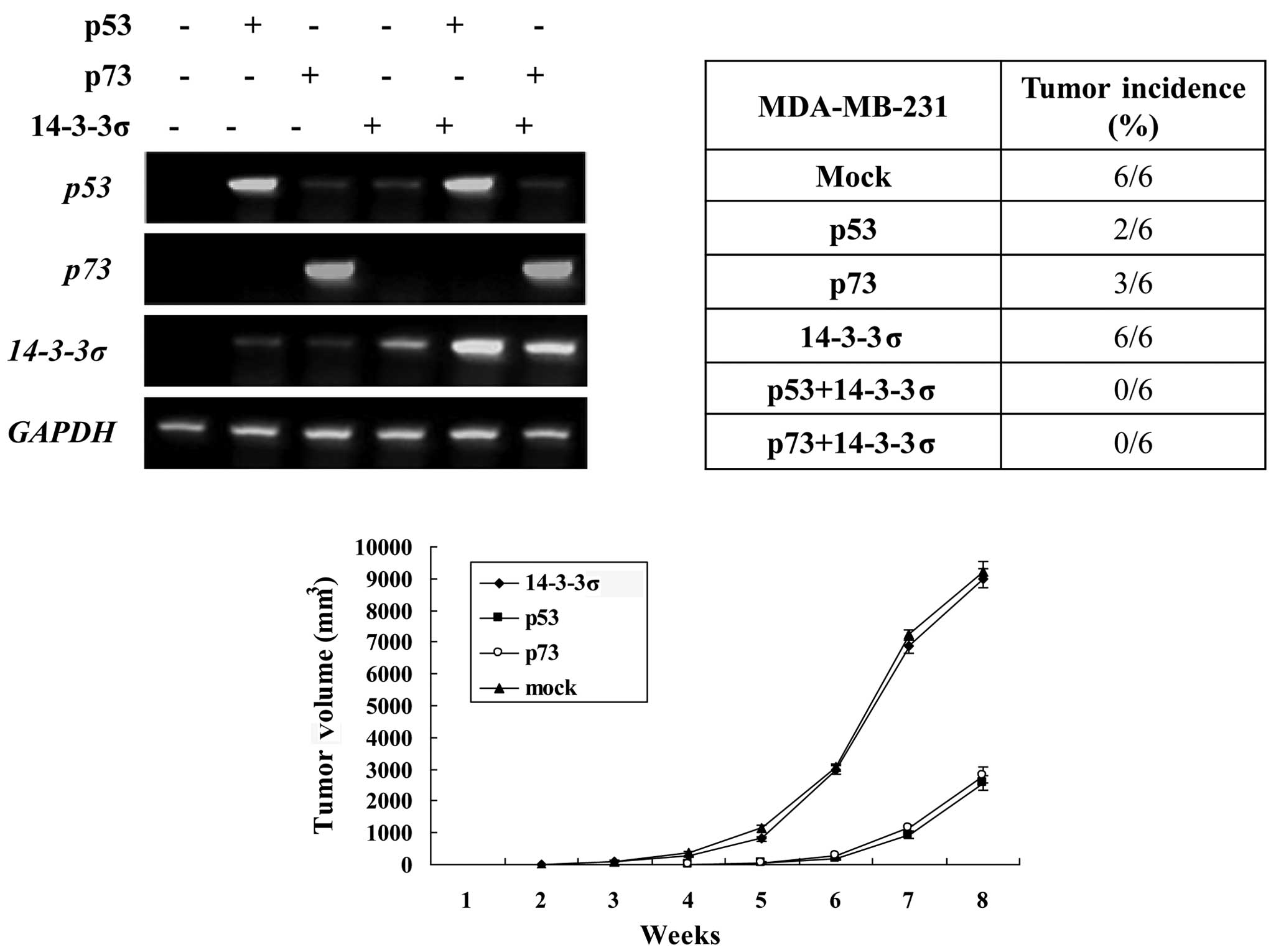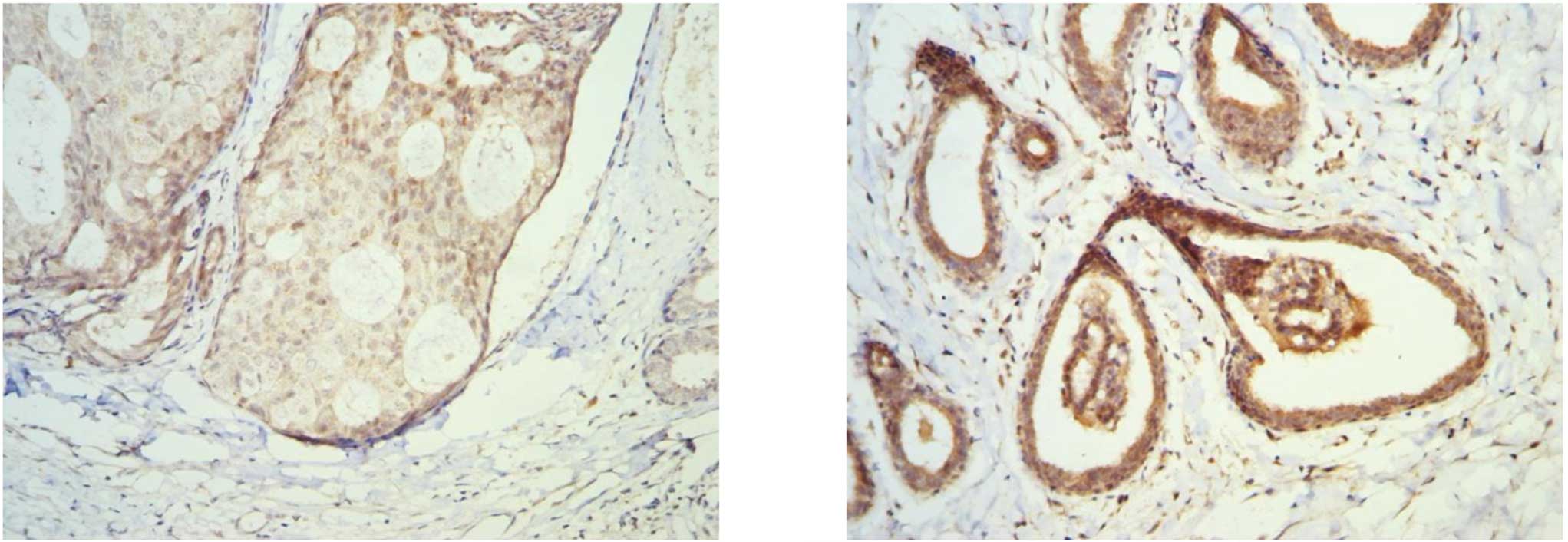|
1
|
Mhawech P: 14-3-3 proteins - an update.
Cell Res. 15:228–236. 2005. View Article : Google Scholar : PubMed/NCBI
|
|
2
|
Rosenquist M: 14-3-3 proteins in
apoptosis. Braz J Med Biol Res. 36:403–408. 2003. View Article : Google Scholar : PubMed/NCBI
|
|
3
|
Fu H, Subramanian RR and Masters SC:
14-3-3 proteins: structure, function, and regulation. Annu Rev
Pharmacol Toxicol. 40:617–647. 2000. View Article : Google Scholar
|
|
4
|
Muslin AJ and Xing H: 14-3-3 proteins:
regulation of subcellular localization by molecular interference.
Cell Signal. 12:703–709. 2000. View Article : Google Scholar : PubMed/NCBI
|
|
5
|
Van Hemert MJ, Steensma HY and van Heusden
GP: 14-3-3 proteins: key regulators of cell division, signalling
and apoptosis. Bioessays. 23:936–946. 2001.PubMed/NCBI
|
|
6
|
Hermeking H: The 14-3-3 cancer connection.
Nature Rev. 3:931–943. 2003.PubMed/NCBI
|
|
7
|
Ferguson AT, Evron E, Umbricht CB, et al:
High frequency of hypermethylation at the 14-3-3σ locus leads to
gene silencing in breast cancer. Proc Natl Acad Sci USA.
97:6049–6054. 2000.
|
|
8
|
Lodygin D and Hermeking H: The role of
epigenetic inactivation of 14-3-3sigma in human cancer. Cell Res.
15:237–246. 2005. View Article : Google Scholar : PubMed/NCBI
|
|
9
|
Iwata N, Yamamoto H, Sasaki S, et al:
Frequent hypermethylation of CpG islands and loss of expression of
the 14-3-3 sigma gene in human hepatocellular carcinoma. Oncogene.
19:5298–5302. 2000. View Article : Google Scholar : PubMed/NCBI
|
|
10
|
Gasco M, Bell AK, Heath V, et al:
Epigenetic inactivation of 14-3-3 sigma in oral carcinoma:
association with p16 (INK4a) silencing and human papillomavirus
negativity. Cancer Res. 62:2072–2076. 2002.PubMed/NCBI
|
|
11
|
Gasco M, Sullivan A, Repellin C, et al:
Coincident inactivation of 14-3-3sigma and p16INK4a is an early
event in vulval squamous neoplasia. Oncogene. 21:1876–1881. 2002.
View Article : Google Scholar : PubMed/NCBI
|
|
12
|
Suzuki H, Itoh F, Toyota M, Kikuchi T,
Kakiuchi H and Imai K: Inactivation of the 14-3-3 sigma gene is
associated with 5V CpG island hypermethylation in human cancers.
Cancer Res. 60:4353–4357. 2000.PubMed/NCBI
|
|
13
|
Ikeda K and Inoue S: Estrogen receptors
and their downstream targets in cancer. Arch Histol Cytol.
67:435–442. 2004. View Article : Google Scholar : PubMed/NCBI
|
|
14
|
Yang H, Zhao R and Lee MH: 14-3-3sigma, a
p53 regulator, suppresses tumor growth of nasopharyngeal carcinoma.
Mol Cancer Ther. 5:253–260. 2006. View Article : Google Scholar : PubMed/NCBI
|
|
15
|
Hermeking H, Lengauer C, Polyak K, et al:
14-3-3 σ is a p53-regulated inhibitor of G2/M progression. Mol
Cell. 1:3–11. 1997.
|
|
16
|
Taylor WR and Stark GR: Regulation of the
G2/M transition by p53. Oncogene. 20:1803–1815. 2001. View Article : Google Scholar : PubMed/NCBI
|
|
17
|
Laronga C, Yang HY, Neel C and Lee MH:
Association of the cyclin-dependent kinases and 14-3-3sigma
negatively regulates cell cycle progression. J Biol Chem.
275:23106–23112. 2000. View Article : Google Scholar : PubMed/NCBI
|
|
18
|
Yang HY, Wen YY, Chen CH, Lozano G and Lee
MH: 14-3-3 σ positively regulates p53 and suppresses tumor growth.
Mol Cell Biol. 23:7096–7107. 2003.
|
|
19
|
Ikawa Z, Nakagawara A and Ikawa Y: p53
family genes: structural comparison, expression and mutation. Cell
Death Differ. 6:1154–1161. 1999. View Article : Google Scholar : PubMed/NCBI
|
|
20
|
Cattoretti G, Rilke F, Andreola S, D’
Amato L and Domenico D: p53 in breast cancer. Int J Cancer.
41:178–183. 1988. View Article : Google Scholar
|
|
21
|
Moll UM, Riou G and Levine AJ: Two
distinct mechanisms alter p53 in breast cancer: mutation and
nuclear exclusion. Proc Natl Acad Sci USA. 89:7262–7266. 1992.
View Article : Google Scholar : PubMed/NCBI
|
|
22
|
Sang M, Li Y, Ozaki T, et al:
p73-dependent induction of 14-3-3 σ increases the chemo-sensitivity
of drug-resistant human breast cancers. Biochem Biophys Res Commun.
347:327–333. 2006.PubMed/NCBI
|
|
23
|
Vayssade M, Haddada H, Faridoni-Laurens L,
Tourpin S, Valent A, Bénard J and Ahomadegbe JC: p73 functionally
replaces p53 in Adriamycin-treated, p53-deficient breast cancer
cells. Int J Cancer. 116:860–869. 2005. View Article : Google Scholar : PubMed/NCBI
|
|
24
|
Prasad GL, Valverius EM, McDuffie E and
Cooper HL: Complementary DNA cloning of a novel epithelial cell
marker protein, Hmel, that may be down-regulated in neoplastic
mammary cells. Cell Growth Differ. 3:507–513. 1992.PubMed/NCBI
|
|
25
|
Vercoutter-Edouart AS, Lemoine J, Le
Bourhis X, et al: Proteomic analysis reveals that 14-3-3σ is
down-regulated in human breast cancer cells. Cancer Res. 61:76–80.
2001.
|












